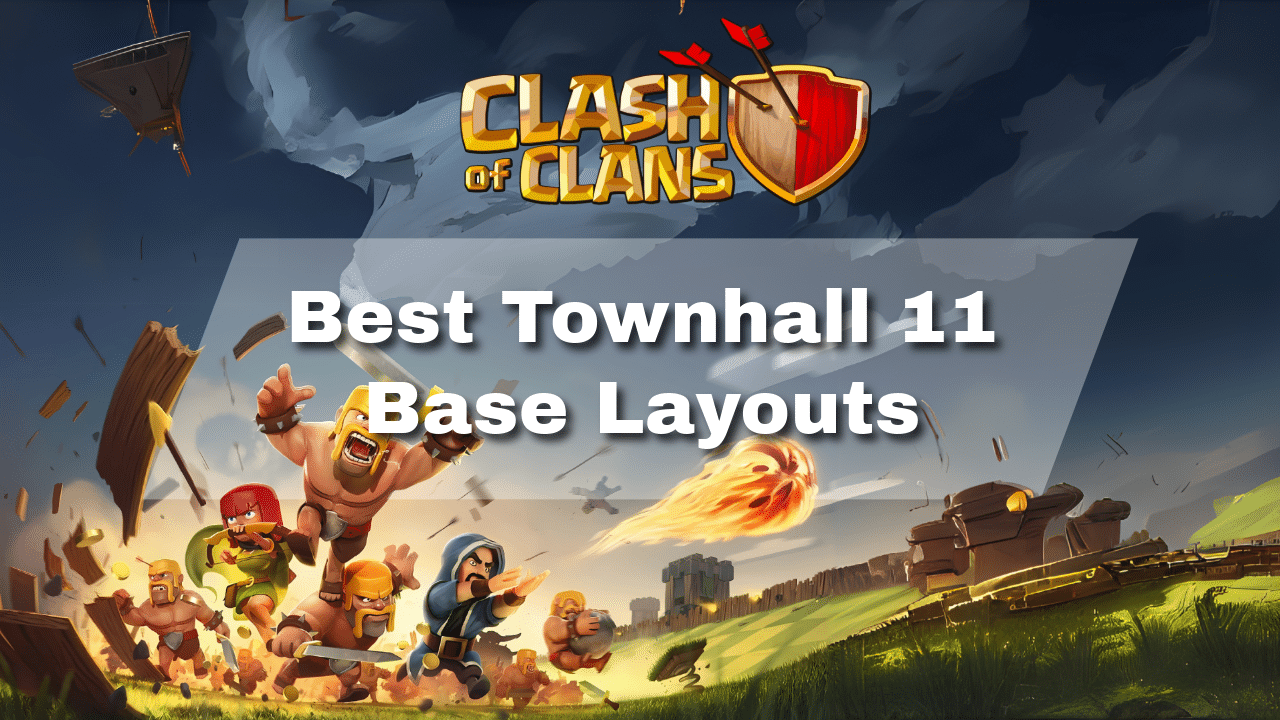Clash Of Clans Best Townhall 11 Base Layout - Theria Games

Introduction to Clash of Clans Best Townhall 11 Base Layout
Town Hall 11 marks a significant shift in Clash of Clans‘ base design, particularly with the introduction of the Eagle Artillery. This powerful long-range defense provides crucial support during attacks, targeting enemy troops anywhere on the battlefield once activated. The Eagle Artillery is capable of dealing massive damage to clusters of troops, making it a key factor in protecting your base.
Its placement must be carefully considered, as it needs to be well-protected while still able to cover a significant area of the base. A poorly positioned Eagle Artillery can be easily taken out early in the attack, reducing its effectiveness and leaving the base vulnerable to a more straightforward raid. Typically, it is placed deeper in the base, surrounded by high-hitpoint structures and defensive traps, ensuring that attackers must commit significant resources to neutralize it.
At Town Hall 11, base designs must be tailored to meet different goals depending on the context. Farming bases are designed to protect resources, especially Dark Elixir, and storages, ensuring that attackers are forced to engage with multiple layers of defense before accessing these critical resources. Trophy pushing bases, on the other hand, focus on maximizing defensive strength to prevent trophy losses while discouraging attackers from easily gaining stars.
War bases prioritize defending against three-star attacks, requiring a more strategic layout that can counter popular attack strategies. Each of these base types requires a distinct approach, and successful designs must balance these various needs while minimizing weaknesses that attackers can exploit.
A key component of effective base design at Town Hall 11 is understanding troop pathing. By predicting how attackers will move through the base, designers can strategically place walls, compartments, and high-damage defenses to force enemy troops into less advantageous paths.
Properly executed, this can make it much harder for attackers to reach critical areas of the base or to take down key defenses efficiently. The placement of walls should funnel attackers toward specific areas, ideally forcing them to walk into the range of powerful defenses or traps. Compartmentalization not only slows attackers down but also prevents them from easily targeting multiple buildings with splash damage units.
Farming Base Layout
A farming base at Town Hall 11 is designed primarily to protect resources, with a strong emphasis on safeguarding dark elixir. Since attackers often aim for storages and collectors, the base layout must make it difficult for them to reach valuable resources easily.
Storages should be positioned within the second layer of defenses, ensuring attackers must break through multiple compartments before gaining access. This setup forces them to commit more troops and spells, increasing the likelihood that their attack will fall short before reaching the core resource storages.
Multi-target Inferno Towers play a crucial role in defending against mass troop attacks. Pairing them with strategically placed Skeleton Traps can stall enemy forces, disrupting their attack timing and forcing them to use healing spells earlier than intended. This weakens their ability to sustain damage as they push deeper into the base.
Resource collectors should also be positioned within the range of defenses to prevent easy sniping. Placing them in a way that forces attackers to engage with key defensive structures ensures that they cannot grab loot without committing to a full-scale attack. This discourages quick farming raids and helps preserve resources over time.
Trophy Pushing Base Layout
A trophy-pushing base at Town Hall 11 focuses on defending against attacks, particularly from air-based armies like Dragons and Balloons, while ensuring steady trophy gains. A strong defensive layout forces attackers into difficult situations, increasing their chances of failure and minimizing trophy losses.
Trap placement is a crucial aspect of base design at this level, as well-placed traps can significantly disrupt enemy strategies. Seeking Air Mines should be positioned near Air Defenses to target Lava Hounds, ensuring they are eliminated before they can tank for Balloons. Meanwhile, a cluster of Red Air Bombs should be placed in the core of the base, where Dragons or Balloons are likely to group up. This concentrated damage can heavily weaken or destroy air units before they reach key defensive structures.
The layout should be designed to guide attackers into unfavorable paths. Compartmentalized bases with offset Inferno Towers and well-placed Air Sweepers can push enemy troops into danger zones, forcing them into traps or extending their path through heavy defenses. By controlling troop movement and placing traps strategically, a trophy-pushing base can effectively repel attacks and help maintain or gain trophies over time.
War Base Layout
A war base at Town Hall 11 is designed to prevent attackers from achieving a three-star victory, with a strong focus on countering popular strategies like Electro Dragon spam and hybrid attacks using Miners and Hog Riders. The layout must be structured to disrupt these strategies and force attackers into difficult situations.
One of the key design principles is spreading out buildings to minimize chain lightning value for Electro Dragons. By spacing defenses and key structures apart, the effectiveness of their chain attack is reduced, making it harder for them to clear large sections of the base quickly.
Traps play a vital role in war base defense, with strategic placements meant to catch attackers off guard. Seeking Air Mines should be positioned to target Electro Dragons as they advance, while unexpected trap locations, such as near the 9:00 position, can throw off attack plans and create additional obstacles for the attacker.
To counter hybrid attacks, Giant Bombs and Spring Traps must be placed in areas where Miners and Hog Riders tend to path. Well-positioned Giant Bombs can weaken groups of Miners, while Spring Traps eliminate Hog Riders, reducing the strength of hybrid pushes before they reach the core of the base.
Defenses like the Eagle Artillery and Inferno Towers are critical to maintaining the base’s strength. These should be placed deep within the base to prevent them from being taken down early. The base should also be structured to ensure that no single section can be easily overwhelmed, forcing attackers to spread their troops and commit significant resources to different areas. This design increases the chances of attackers running out of time or troops before securing three stars.
Key Defensive Strategies and Placements
The Eagle Artillery:
It is one of the most dominant defenses introduced at Town Hall 11, capable of dealing devastating damage to enemy troops from long range. Unlike other defenses, it activates only after a certain amount of troop housing space has been deployed, making it a key element in defending against large-scale attacks. Due to its immense power, attackers will often prioritize taking it down early in a raid. To prevent this, the Eagle Artillery should be placed deep within the base, surrounded by high-hitpoint structures and protected by key defenses such as Inferno Towers and X-Bows. A well-defended Eagle Artillery can continuously weaken enemy forces throughout the attack, reducing the effectiveness of late-stage reinforcements and preventing a full base takedown.
Multi-Target Inferno Towers:
Play a crucial role in defending against both high-hitpoint troops and swarm attacks. Unlike Single-Target Infernos, which are better suited for taking down powerful individual units, the Multi-Target mode allows Inferno Towers to damage multiple troops simultaneously, making them especially effective against hybrid attacks involving Miners, Hog Riders, and Bowlers. Proper placement of Inferno Towers is essential, as they should be separated into different compartments to force attackers to invest multiple spells, such as Freeze or Heal, to keep their troops alive. By placing them in locations where attackers must work hard to reach them, the overall effectiveness of the base’s defenses increases, creating more opportunities for attackers to fail before reaching key objectives.
Trap placement :
Is an essential component of a strong base design, as well-placed traps can change the outcome of an attack by eliminating key enemy units. Red Air Bombs should be positioned to target groups of Balloons or Dragons as they progress through the base, while Seeking Air Mines are best placed near Air Defenses to weaken Lava Hounds before they soak up damage for Balloons.
On the ground, Giant Bombs should be placed in areas where enemy ground troops, especially Miners and Hog Riders, tend to converge. Spring Traps can be positioned along key paths to eliminate Hog Riders or Giants before they reach important defenses. Skeleton Traps should be set to target either air or ground troops based on the most common threats in the meta, adding an extra layer of disruption by distracting attacking forces.
Air Defenses:
Are the backbone of the anti-air base design, making them critical for countering powerful aerial attacks such as LavaLoon and mass Dragons. Their placement should be spread out across the base to ensure that attackers cannot easily eliminate multiple Air Defenses at once with spells like Lightning or a well-placed Queen Charge.
Keeping them spaced apart prevents attackers from getting excessive value with a single Rage Spell, forcing them to invest more spells and resources to push deeper into the base. Pairing Air Defenses with Seeking Air Mines and Red Air Bombs increases their effectiveness, ensuring that enemy air troops take additional damage as they approach. Placing Archer Towers and X-Bows in air mode alongside Air Defenses can further strengthen anti-air coverage.
Defenses:
Plays a crucial role in ensuring that attackers do not get too much value from a single spell or group of troops. If defenses are too clumped together, a single Freeze or Poison Spell can neutralize multiple key buildings at once, making it easier for attackers to push through. A well-balanced base layout should force attackers to spread their troops across multiple sections, preventing them from overwhelming one area too easily.
The layout should also ensure that no specific attack strategy can fully exploit a weakness in the base, requiring attackers to adapt and use more resources than they originally planned. By carefully structuring defenses and maintaining a balanced spread, a Town Hall 11 base can effectively counter a wide range of attack strategies and increase the chances of a successful defense.
Strategic Considerations
A strong base design must continually adapt to the evolving meta, as attack strategies frequently shift. To stay competitive, a base should be capable of handling the most common and powerful attack strategies in the current game. This requires ongoing adjustments to the layout, particularly when it comes to defensive structures and traps.
For instance, as new attack methods emerge, base designers must ensure that defenses are strategically placed to counter both ground and air-based strategies. This might include modifying trap placements, repositioning high-damage defenses, or reinforcing areas that are particularly vulnerable to popular attack strategies, such as air raids or hybrid armies. By staying ahead of these changes, a base can remain resilient against a variety of threats.
Anticipating attacker behavior is a critical element of effective base design. Understanding how attackers typically approach a base allows for more targeted and strategic placement of traps and defenses. For example, common strategies such as Queen Charges, Electro Dragon attacks, and hybrid attacks involving both ground and air troops should be considered when designing the base layout.
A Queen Charge, for example, often involves a slow methodical approach to the core of the base, so positioning defenses and traps to stall or damage the Queen and healers can disrupt this strategy. Similarly, hybrid attacks that combine Hog Riders and Miners require defenses to be spread out in such a way that these troops cannot easily target key buildings. By predicting how attackers are likely to approach, base builders can design layouts that force attackers into unfavorable situations, where their troops are either slowed down or neutralized by strategically placed defenses.
In farming base designs, balancing defense with resource protection is particularly important. While protecting against full-scale attacks is always a priority, it’s equally important to ensure that storages are well-protected without compromising the overall integrity of the base structure. The goal is to keep resources secure while preventing attackers from easily reaching them. A good farming base layout ensures that storages are tucked within layers of defenses, forcing attackers to commit more troops and resources to gain access.
This strategy minimizes the risk of losing a large amount of resources while still maintaining strong defensive coverage. At the same time, the layout should prevent easy trophy losses, ensuring that attackers who focus on resource raiding are also met with significant resistance. In this way, a balance is struck between defense and resource protection, providing an efficient and resilient base.
Specific Tactics
Layered defenses are a critical component of the base design, as they serve to slow down and weaken attacking troops as they make their way through the base. A well-structured base with multiple compartments and staggered defenses forces attackers to break through several layers, which not only delays their progress but also increases the resources and time they must commit to completing the raid. As attackers push deeper into the base, their effectiveness diminishes because they must expend more spells and troops earlier in the attack, leaving them with fewer resources to deal with remaining defenses.
By creating these layers, base designers can disrupt the rhythm of an attack. For example, attacking troops may be forced to funnel into specific paths, facing one layer of defenses after another. Each compartment slows them down, buys more time for defenses to fire, and forces the attacker to adapt their strategy. The more layers an attacker has to break through, the more likely it is that the raid will lose momentum, making it harder to achieve a three-star victory.
Trap placement is an additional layer of defense that can make or break an attack. By positioning traps near key defensive structures, such as Air Defenses or Inferno Towers, defenders can further disrupt an attack before it deals significant damage. Seeking Air Mines and Red Air Bombs should be placed near Air Defenses to weaken aerial pushes, such as those involving Balloons or Dragons.
These traps prevent attackers from easily reaching their target defenses without losing critical units. On the ground, Giant Bombs and Spring Traps can be placed near high-value defenses like X-Bows or Inferno Towers, eliminating or severely damaging key attacking troops like Hog Riders or Giants before they can reach their objectives. The proper use of traps adds another layer of unpredictability for attackers, forcing them to either waste spells or adjust their troop deployment strategies.
High-hitpoint buildings, particularly storages, are invaluable when used as defensive barriers. These structures take significantly longer to destroy, which forces attackers to spend more time trying to eliminate them. When placed strategically within the base, storages act as natural obstacles, slowing down enemy troops and buying precious time for defensive structures to eliminate threats. Furthermore, placing storages in front of core defenses such as the Eagle Artillery or Inferno Towers can absorb damage, making it harder for attackers to break through to these crucial structures. By creating a buffer with storages, you allow defenses more time to neutralize attacking troops, giving your base a better chance of holding up against a raid.
Together, layered defenses, trap placement, and the strategic positioning of high-hitpoint buildings combine to create a robust defense that forces attackers to work harder and use more resources, all while protecting the core of the base.













